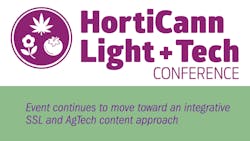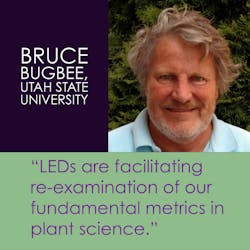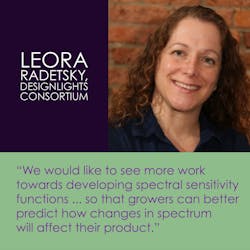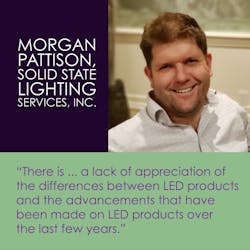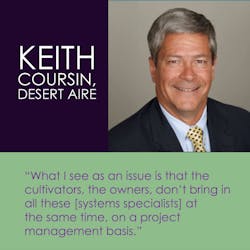In early 2019, the LEDs Magazine team and Lighting group at Endeavor Business Media convened planning for the annual Horticultural Lighting Conference. It was determined based on counsel by our longtime media and events advisors, as well as surveys to our sphere of readers, conference attendees, and stakeholders in the LED and solid-state lighting (SSL) supply chain, that the penetration of LED-based horticultural lighting was becoming even more complex as the scientific study of plant responses to light continues to evolve and the application of advanced technology becomes more integral to emerging controlled environment agriculture (CEA) operations. That data drove the decision to rebrand the event last year as the HortiCann Light + Tech conference to better reflect the expanded scope of related grower technologies and the importance of the cannabis market as a driver of SSL and integrated systems in CEA. The events of 2020 may have changed the way the conference is delivered, but the message remains clear: An integrated approach to technology-based farming will emerge based on environmental, efficiency, and consumer demands, backed by evidence-based research and commercial successes that continue to inform its evolution and application.
Although the global health crisis caused by the novel coronavirus pandemic has pushed HortiCann Light + Tech to a virtual format in 2020, the conference will maintain its focus on sharing advances, research, and case studies regarding lighting optimization, efficacy, energy savings, operations and environmental control systems, and strategies for integrating multiple AgTech systems. The program will take place over Oct. 20‒21 online to allow a bit of breathing room in the virtual format.
Framing the future of farming
Now, certainly the global pandemic has thrown a curveball into the entire agricultural and horticultural supply chain’s expectations — from reduced harvesting workforce to transport delays to outright shutdowns at facilities where coronavirus cases have been reported.
We at LEDs Magazine do not have current statistics from our sister market-research firm, Strategies Unlimited, on how the horticultural lighting market forecast may have changed as a result of the pandemic, but we feel confident in stating that since most technology industry sectors have seen a slowdown in supply chain, manufacturing, and purchasing in 2020, these factors would in turn influence the uptake of advanced technology such as LED-based SSL and integrated controls and environmental systems, with concerns about expenses versus revenue perhaps dictating a hold on buying decisions.
Despite the unanticipated pandemic-related obstacles, some publications we follow, such as HortiDaily, have repeatedly published stories from within the horticultural community which support the idea that a growing population with diminishing arable land available will inevitably come to rely upon CEA — in the form of conventional greenhouses, localized container farms, large-scale vertical farming facilities, and all combinations thereof — to maintain a safe and sustainable food-supply chain. Furthermore, in a recent blog, we noted US Department of Agriculture (USDA) support of AgTech education with a $496,000 federal grant that will enable several institutions to expand their curricula and training for a new generation of technically-inclined farming specialists. This funding support indicates recognition of the demands on the agriculture sector to move toward modern measures of food production while managing the impact on the environment and food quality.
Perspective on performance and efficiency
At the 2019 conference, keynote speaker Dr. Neil Mattson, PhD, of Cornell University’s GLASE (Greenhouse Lighting and Systems Engineering) Consortium cited information from the US Department of Energy (DOE) on agricultural- and horticultural-related lighting, saying, “It’s been estimated that there is going to be an almost 20% increase in lit area per year over the next several years.”
In a report from its Office of Energy Efficiency & Renewable Energy updated this past June, the DOE’s investigators stated, “If all horticultural lighting today was converted to LED technology, annual horticultural lighting consumption would be reduced to 6.3 TWh of site electricity, or 60 tBtu of source energy, which represents lighting energy savings of 34% or $350 million annually.”
Allow those numbers to sink in for a moment. At LEDs Magazine, we often comment on the state of general illumination and progress toward light quality now that LEDification is well on its way. However, the agricultural and horticultural applications represent an enormous opportunity for significant reductions in lighting-based energy consumption, so energy efficiency discussions are still very much on the table.
For an SSL fixture to meet the needs of a horticultural application, it must deliver an appropriate amount of PAR. Now, the spectrum of the LEDs engineered into a fixture can vary within this recognized PAR range, and at varying spectral output and power, the efficiency of the LEDs will also differ. Ultimately, some experts have advised that tradeoffs will be made depending on the priorities of the facility for which the LED lighting is being specified. Light recipes might require more white or more red LEDs, or more phosphor-converted blue LEDs, which exhibit lower efficiency. (This, as you might expect, is a highly simplified explanation of complicated concepts in how plants utilize photons, and how devices make a difference to product performance.)
Still, recommendations on how to implement technology change as new data emerges. According to keynote speaker Dr. Bruce Bugbee, PhD, professor of crop physiology at Utah State University, “LEDs are facilitating re-examination of our fundamental metrics in plant science. The research indicates that our definition of photosynthetic radiation needs to change, and our definition of spectral quality and phytochrome needs to change.”
Bugbee and his colleagues have been researching the current concept of PAR. At the same time, they have compared the current efficacy of LEDs and the approaching limit to the conversion of electric energy into photons. During the keynote, Bugbee will discuss device- and system-level performance characteristics that impact LED efficacy — among them drive current, junction temperature, operating temperature, and photon-conversion and system optical losses — establishing detailed connections between spectral output ranges and their influence on such LED characteristics. Ultimately, his team’s research indicates how new data on cost, efficiency, and plant-response factors can be optimized and balanced to evaluate the usefulness and efficacy of SSL fixtures in specific CEA applications. (See a link to an open-access paper on the findings published this year in the journal Horticulture Research, on which Bugbee collaborated with Utah State PhD student Paul Kusuma and Dr. Morgan Pattison, who incidentally will also be speaking at HortiCann.)
This kind of disclosure brings a new dimension to the latest thinking on development and commercialization of SSL product. How do industry stakeholders harness the research on LED capabilities to their advantage? The answer is that organizations responsible for standardization, recommendations on best practices, and stewardship of technical requirements — such as the DesignLights Consortium (DLC), ASABE, and the Illuminating Engineering Society (IES) Horticultural Lighting Committee — collect the data and use it to inform the industry’s work in moving horticultural lighting and AgTech systems forward.
“It’s somewhat more challenging for LED grow-light manufacturers to ensure that their data is characterized in terms of plant responses rather than photopic or radiometric responses. However, given that the absolute and spectral range that plants are sensitive to is broader and varies from people’s responses, it’s important that we characterize this type of lighting accurately,” said Radetsky. “The DLC staff participate in ASABE and IES horticulture committees so that we can use these evolving consensus-based standards to refine our technical specifications. Looking forward, the lighting metrics used for plants continue to revolve around photosynthesis rather than other important outcome measures, such as the spectral sensitivity of cannabinoids, for example. We would like to see more work towards developing spectral sensitivity functions for these outcome measures so that growers can better predict how changes in spectrum will affect their product.”
The toolbox for successful SSL
Building up from the device and system foundations for product development, the HortiCann program will also appeal to the systems integrators as well as specifiers/buyers of the finished product, from SSL to HVAC and more. Ensuring that all of these discrete devices, hardware, and software work together to enhance the grower’s toolbox is a complex responsibility, but one that can be undertaken with the right counsel and custom solutions for the application.
While there are plenty of advantages to upgrading to LED lighting and incorporating more engineered growing methods, understanding all the moving parts can be overwhelming without solid guidance. As consultant Morgan Pattison of Solid State Lighting Services, Inc. has found, there are misconceptions that need to be cleared up before anyone can make an informed decision about incorporating LED technology into farming operations.
“From the buyer perspective, I think there is still misunderstanding of LED technology including an over-emphasis on the impacts of spectrum,” Pattison said. “There is also a lack of appreciation of the differences between LED products and the advancements that have been made on LED products over the last few years.”
At HortiCann, he will bring perspective to the large-scale energy savings of converting to LEDs, outlining the theoretical and practical performance of what LED lighting can achieve in terms of horticultural performance, and will provide a broad review of commercial lighting product performance.
Significant strides in the interoperability and programmability of all manner of sensors, controls, and other hardware (including lighting) have been made over the past several years. With the advent of the Internet of Things (IoT), more niche companies have played the odds on the intersection of IoT, lighting, and applications like CEA. At last year’s event, for instance, Dr. Shivangi Arvind of AgEye emphasized that a long-term objective for continued progress in CEA would rely on an “Artificial Intelligence of Things,” or “AIoT,” centralizing control of all devices in horticultural operations into a network that can not only be manually designed and customized but can analyze and adjust via machine learning and automation.
Taking the canna-biz seriously
As stated earlier in this preview and summarized in a blog from January, the legalized cannabis boom has created an incredible investment opportunity, as well as new business for all manner of technology providers and consultancies.
The full consultative approach to outfitting a grower operation, especially in the legalized cannabis cultivation sector, relies on equipment that may have in the past been considered utilitarian, and not until the last stages of a build. Heating, ventilation, and air conditioning (HVAC) has come a long way in terms of technology advances, automation, and machine learning. When designing systems to manage the indoor environment, HVAC specialist Desert Aire takes an all-inclusive look at the entire operation — controls and equipment, light, water usage, nutrient management, everything that impacts the crop characteristics and yield, said president and HortiCann panelist Keith Coursin.
Over the five years that Desert Aire has been servicing the cannabis grow market, he said, his staff has learned that growers might have a number in mind as far as the humidification value or the size of the HVAC unit that may not be appropriate for the real-world results they desire. And it’s up to the contractors and systems developers involved to educate the customer, factoring in the relationships between heat from equipment, humidity that must be maintained at different levels during the cannabis lifecycle, and the value in applying advanced, customized systems that ultimately boost the growers’ bottom line. On the panel, he will bring the HVAC role into perspective as another piece of smart equipment that can be added to the CEA toolbox. And the systems are infinitely more sophisticated than you might expect, with a fourth-generation control algorithm in place now.
“I heard from a recent [cannabis] customer of ours that has now been in operation for three years, and they made the comment once again that ‘This quarter we’ve increased our output by 20%.’ And that wasn’t just because they had our units in it,” Coursin explained. “They’ve been tweaking their whole process to continue to get the weight of product improving, because if you’re shipping more pounds, more kilograms, whatever unit of measure you want, for that same space, for that same utility cost… I’m a manufacturing guy. That’s called cost of goods sold. You cover that nut, that’s called profit.”
Beyond offering equipment rebates and incentives, utilities like SMUD are evolving into partnership with legal cannabis growers and are becoming an integral part of the conversation when it comes to green building and retrofitting existing operations with modern, energy-saving, and intelligent systems, whether for HVAC, lighting, or other CEA management activities and conditions.
By and large, the HortiCann Light + Tech conference continues to move toward a holistic and integrative content approach that matches the needs of a mixture of audience demographics — from component engineers to SSL developers to lighting specifiers and buyers and the end-user base of growers who desire a thorough understanding of the options, value, and practical application of innovative SSL and AgTech solutions. Register now for free to expand your knowledge base online with us from Oct. 20‒21, 2020.
*Updated Sept. 9, 2020 5:20 PM for photo replacement.
*Updated Oct. 6, 2020 11:15 AM for additions to content from October 2020 issue of LEDs Magazine.
For up-to-the-minute LED and SSL updates, why not follow us on Twitter? You’ll find curated content and commentary, as well as information on industry events, webcasts, and surveys on our LinkedIn Company Page and our Facebook page.
